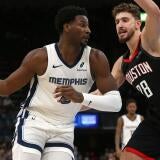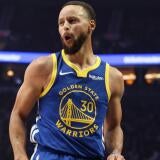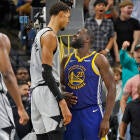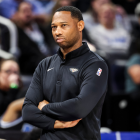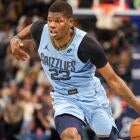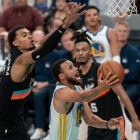10 of the craziest, weirdest and most significant early season NBA stats from Nikola Jokić, Giannis and more
Nikola Jokić, Jaylen Brown and Giannis Antetokounmpo are doing unprecedented stuff
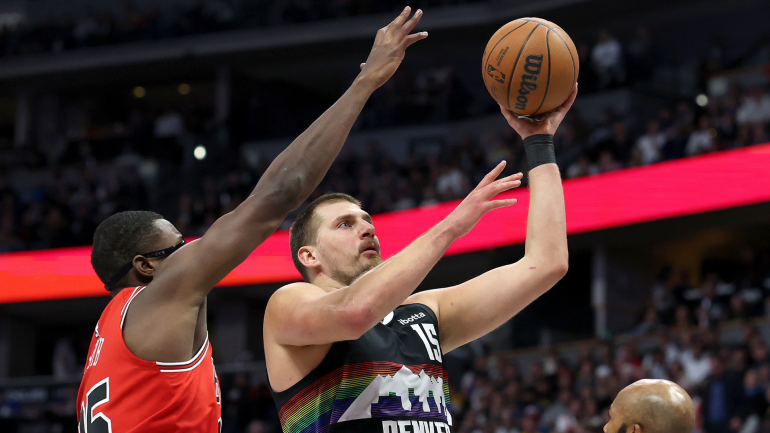
The NBA season is long and it is still early. If your favorite team is underperforming, remember that more than 80% of its games have yet to be played. The Indiana Pacers were under .500 this time last year, but went on to make the Finals.
That said, four weeks in, we're not talking about tiny samples anymore, so citing 2025-26 statistics no longer feels silly. Here are 10 stats (through games played on Nov. 16) that seem significant, completely crazy or both:
1. Jokić is spoon-feeding the Nuggets like never before
Nikola Jokić can still score whenever he wants, as he showed when he dropped 55 on a Los Angeles Clippers team that insisted on single-covering him last week. Generally speaking, though, he'd prefer to find easy baskets for his teammates. And he's doing that at a ridiculous rate.
It's not just that Jokić is leading the league in assists. It's that, of his career-high 15 assists per 100 possessions, 8.8 per 100 have led to baskets at the rim, per databallr.
That is a stupid number. Last season, Jokić averaged 6.5 rim assists per 100 possessions, which was good for second in the league. In 2022-23, when the Denver Nuggets went on to win the title, he averaged 7.5 per 100. The last person to average eight rim assists per 100 possessions for a full season was Russell Westbrook, who did it in 2017, the year he won MVP and had the ball in his hands for 9.2 minutes every game. Jokić's average time of possession is less than half of that: 4.3 minutes per game.
Databallr tracks rim assists dating back to the 2000-2001 season. Steve Nash averaged 8.5 per 100 in 2006-2007 and 2007-2008, but no one else has come close to what Jokić is doing now.
2. Brown the midrange machine
We knew Jaylen Brown's life would be different without Jayson Tatum (and Jrue Holiday, Kristaps Porzingis, Al Horford and Luke Kornet). We knew the Boston Celtics needed him to create more offense and we knew he'd have to do it against loaded-up defenses.
If we knew that, then he certainly did too. And he had an offseason to prepare for his new situation. Maybe we shouldn't be shocked, then, that he has put up superstar numbers through 14 games. Brown has averaged 27.4 points, 5.6 rebounds and 4.1 assists in 32.1 minutes, with a career-high true shooting percentage (58.7%) and a career-high usage rate (34.1%).
The sheer volume, though, is astounding. On a per-possession basis, no one in Celtics history has scored like this for a full season. And he's doing an enormous amount of his damage from what is supposed to be the least efficient area on the court.
Brown has attempted 9.5 long 2s per 100 possessions and made 54.7% of them, per databallr. Last season, he attempted 3.2 per 100 and made 42.1%.
This season, in terms of getting those shots up, Brown has been a total outlier. DeMar DeRozan has taken 7.0 long 2s per 100 possessions, Joel Embiid 6.9 per 100. Shai Gilgeous-Alexander and Kevin Durant have both taken 5.7 per 100.
And in terms of midrange efficiency, Brown is a historical outlier right now. Since 2000-2001, no one has shot long 2s this frequently and this well for a full season, per databallr. Durant has shot better than 50% on long 2s in eight separate seasons (and is at 49% this year), but, in each of those seasons, he attempted between five and seven of them per 100 possessions.
What Brown is doing is probably not sustainable. But it's insanely impressive.
3. Cunningham's wacky 3-point splits
Cade Cunningham has made just 28.8% of his 3s, but I've never felt better about his jumper. Yes, I realize how crazy this sounds, but hear me out.
Cunningham's shooting numbers look bad because he has missed 18 of the 21 catch-and-shoot 3s he has attempted. Given that the Detroit Pistons star had previously improved as a spot-up shooter in every season that preceded this one (and he made 39.2% of his catch-and-shot 3s in 2024-25), I'm reading much into this. The 3s that I care about are the ones he's taking off the dribble.
In 2024-25, Cunningham's first All-Star and All-NBA season, he attempted more 3s off the dribble than ever before, but he was still significantly more comfortable off the catch. In his first playoff series, he couldn't make the New York Knicks pay for going under screens, shooting just 4 for 25 on pull-up 3s.
Cunningham knew what he had to work on and, while he hasn't turned into Stephen Curry -- he has shot 18 for 52 (34.6%) on pull-up 3s, only slightly more efficient than last season -- his improved confidence is obvious. He is now actively hunting 3s when he comes off pick-and-rolls.
On the season, Cunningham has taken about one more pull-up 3 per 100 possessions than he did last season and he has attempted pull-up 3s more than twice as often as he has attempted spot-up 3s. Given that the Pistons have issues spacing the floor, this is a particularly significant development.
4. The Pistons' preposterous paint protector
One more note on Detroit: While Isaiah Stewart is only 6-foot-8, he has become one of the league's premier interior defenders. Opponents have shot just 47.3% at the rim against Stewart, the third-best mark in the league (minimum 40 attempts), and, according to Cleaning the Glass, Detroit has surrendered fewer shots at the rim when Stewart is on the court than the Spurs have with Victor Wembanyama on the court.
In Stewart's minutes, only 23.5% of opponents' shots have come at the rim, per CTG. And when he has shared the floor with fellow big Jalen Duren, only 17.4% of opponents' shots have come at the rim. (For reference, that number is 23% for the Utah Jazz, the team that allows the fewest rim attempts of any team in the league, and 27% for the Oklahoma City Thunder, the team that allows the second-fewest.)
Stewart and Duren have logged only 80 minutes so far this season, but a) that's 72 more than last season and b) the Pistons have dominated those minutes. I'm not sure if this double-big look is viable, but it may be worth a look if only because it would allow coach J.B. Bickerstaff to give more playing time to two of their best players. Duren has earned a fair amount of attention for his breakout year and Detroit is a tougher, meaner team whenever Stewart is patrolling the paint.
5. Houston, we have an offense
The Rockets are playing gigantic lineups and bullying everybody on the boards, but second chance points don't tell the whole story. Through 12 games, Houston has scored 105.5 first chance points per 100 possessions, the fifth-best mark in the league, per PBPstats. And with Alperen Sengun on the court, that number is 108.7, which is better than the Denver Nuggets' league-best mark (107.2).
Last season, the Rockets scored just 97.5 first chance points per 100 possessions, which ranked 22nd in the league, per PBPstats. They are getting to the free throw line way more often now and, while they're taking fewer 3s than anybody else, they're making a league-high 42.6% on them. Some of that is the Durant effect, but it's worth noting that Reed Sheppard, Tari Eason, Sengun and Josh Okogie have shot a combined 47.7% from deep.
It's been an encouraging start, but I'm curious to see if this formula holds up. The Nuggets have proven that you don't have to shoot tons of 3s to have an awesome offense, but this is pretty extreme. Sengun's improvement as a shooter would be more of a game-changer if he shot 3s more often, wouldn't it?
6. Sheppard the pest
In Houston's last six games, Sheppard scored an average of 15.7 points on 74.9% true shooting and shot a total of 20 for 38 (52.6%) from deep. He is such an elite shooter that, after a win over the Wizards, he said that teammate Amen Thompson had told him, "If you take one more dribble when you're open and there's no shooting, I'm gonna punch you in the face."
The big question with Sheppard, though, is what kind of a defender he can be at this level. Opponents routinely target him in pick-and-rolls and he sat on the sideline for most of his rookie season because it was simpler for the Rockets -- a switch-heavy defensive team -- to not deal with his one-on-one limitations.
Good news: Sheppard has averaged 9.2 deflections per 100 possessions, the best mark in the entire league this season (minimum 150 minutes played), per databallr. He has also averaged 3.3 steals per 100 possessions, which is exactly as many as Hawks stopper Dyson Daniels has managed.
To be clear, Sheppard is no stopper. He averaged 4.4 stocks per game in college, though, and has a knack for making sneaky plays on and off the ball. At his best, he's a real pest.
7. Good grief, Giannis
Every opponent of the Milwaukee Bucks wants to keep Giannis Antetokounmpo out of the paint. No one can do it. Antetokounmpo has attempted 20.2 shots at the rim per 100 possessions, the most of anyone in the league by a wide margin, and has made 76.3% of those shots, per databallr.
No one in databallr's database has done this for a full season. The only player who has generated rim attempts this frequently was Zion Williamson in 2019-20, his rookie season. Williamson actually attempted 21 rim attempts per 100 possessions that year, but converted only 62.3% of them.
For Antetokounmpo, this is an unbelievable uptick. Last season, he averaged a league-high 15.9 rim attempts per 100 possessions and made 74.9% of those shots. With Damian Lillard out of the picture, Antetokounmpo has a heavier playmaking burden than ever before, but he has somehow never been more efficient.
For the Bucks, this is amazing and at least a little alarming. They are asking an awful lot of him and it remains to be seen how his body will hold up. (Antetokounmpo left Monday's game in Cleveland with a groin injury.)
8. The Raptors, off to the races
Playing fast is not new for the Toronto Raptors, but they've dialed it up this season. They're averaging a league-high 21.8 fast break points per 100 possessions, a full three points more than anybody else in the league, and, according to Cleaning The Glass, they are first in transition frequency (20.3%) by a significant margin, too.
No team has put up either of those numbers in a full season since the Durant-era Golden State Warriors, who scored 22.4 fast break points per 100 possessions in 2016-17 and had a transition frequency of 20.3% in 2017-18.
The Raptors foul a lot and have struggled with defensive rebounding. They've been far better than they were projected to be on offense, though, in part because they've been pushing the ball like maniacs. Individually, RJ Barrett has scored more fast break points (63) than anybody in the league other than Antetokounmpo.
9. Fontecchio's green light
Before a recent game in New York, Miami Heat coach Erik Spoelstra said that the team needed wing Simone Fontecchio to be "free in the mind," like he is when he plays for the Italian national team.
"We want him to have the utmost confidence and a neon green light to be aggressive," Spoelstra said.
In this respect, Spoelstra is pleased as punch. Fontecchio has not been shy this season. After making just 33.5% of his 8.6 3-point attempts per 100 possessions with the Detroit Pistons last season, he has gotten up 12.2 3s per 100 possessions and made 49.3% of them with the Heat.
As awesome as Miami's new offense has been, it has not produced an endless amount of wide-open looks for Fontecchio. That is some of it, sure, but to increase his 3-point volume this much he needed to take advantage of that green light. The guy is letting it fly from deep, off movement and with a hand in his face.
Based on the difficulty level of Fontecchio's 3-point attempts, an average NBA player would have made 34.2% of them, according to the NBA's new "Inside The Game" stats, which are drawn from player tracking data. Fontecchio's 3-point percentage above expected (+15.1%) is tops in the league.
10. Driver's license
The Portland Trail Blazers' Deni Avdija and the Chicago Bulls' Josh Giddey are having career years largely because they're among the league leaders in drives. From the start of the season, they've seemed intent on getting into the paint, initiating contact and taking advantage of their size.
There is one player, however, whose increased aggressiveness getting downhill has stood out even more to me. This player is not driving nearly as often as Avdija (18.3 drives per game) or Giddey (17.5). In fact, on a per-game basis, he's driving about as often as those guys did last season. But that's a lot for him and he has completely transformed his game.
The player in question? Grayson Allen of the Phoenix Suns. With Durant and Bradley Beal gone and the team desperate to put any kind of pressure on the rim, new coach Jordan Ott has empowered Allen. The 30-year-old guard has been running pick-and-rolls, attacking closeouts and generally doing more with the ball in his hands than anyone could have expected. After averaging 5.0 drives per game last season, he's averaging 10.4 through 13 games this season.
Allen has been more aggressive in every way and it hasn't come at any cost. He's taking more shots and getting more assists, but has remained extremely efficient and has seen only a slight increase in turnovers. I'm not sure that Phoenix will remain a top-10 offense, but it's not some weird fluke that Allen had a 42-point game last week. He looks like a totally different guy.


